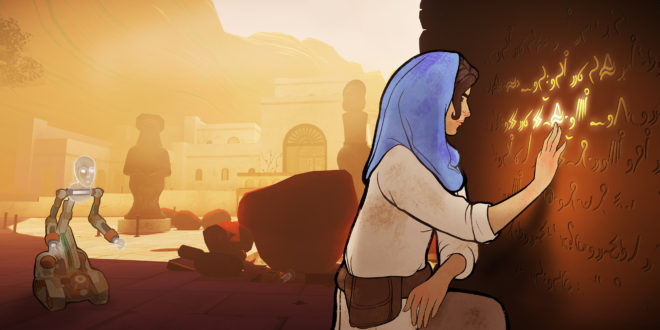Inkle loves words. The studio has approaching 30,000 lines of dialogue in its upcoming PS4 and PC game, Heaven’s Vault. All of that text is then managed by a custom scripting engine which generates narrative on the fly by mixing and matching conversational topics from that huge library of lines. But that’s not all, for Heaven’s Vault also contains an entire invented hieroglyphic language, which the player, as far-future archeologist Aliya, must decode as the game progresses.
With the title coming out in less than a week, after four years in development, we had a chat with Inkle co-founders Joseph Humfrey (art and code director) and Jon Ingold (narrative director) to discuss the game, the powerful scripting technology behind it, and all those lovely, lovely words.
A game in which you play an archeologist is a pretty unusual starting point – that is discounting Lara Croft, who spends more time shooting things than she does digging for relics or translating ancient languages.
Humfrey tells us that the idea for a sci-fi archeology game came to Ingold in the middle of night – possibly related to binge-viewing Stargate. Ingold laughs and notes: “That’s a coincidence. I do like Stargate but it’s not really about archaeologists, it’s mostly a military show. But the hook is space archaeology,” he accepts.
So Ingold researched the “golden age of archeology” in the early 20th century: “But the more you read about it the more you realise it’s a complete marketing spin on a bunch of very rich people who paid their academic friends to go and steal stuff from other countries.”
But this kind of acquisitive colonialism didn’t appeal to the eight-strong team.
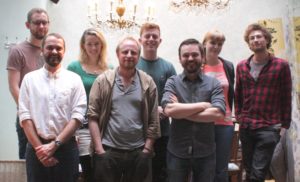
“Then I started trying to read about more modern archaeologists, I found this lady called Dr Monica Hanna, who is an Egyptian Egyptologist, who has been working since the Arab Spring uprising to prevent looting,” Ingold says. He goes on to explain that Hanna was trying to prevent Egpytians from looting their own museums, which represented to many the widely-despised government of the day.
And it was that which made Ingold realise that “archaeology could be relevant politically, in the modern world.” He continues: “It’s not just cultural tourism, it’s actually live political matter right now and that made me think: ‘Actually, this is something I can write a story about’.”
This also, in part, explains the studio’s motivation behind its choice of protagonist: “Having drawn from that, the idea of casting our archaeologist as anyone apart from a woman of colour seemed just absurd really.

“I definitely don’t want to suggest that our character is Dr Hanna,” Ingold however notes. “She’s a real person with a real life and she probably doesn’t want to be dragged into the game’s spotlight.”
Humfrey adds: “When we came off the back of 80 Days, which was itself massively focused on diversity, we both had this sense of: we’ve just done a game about two dudes travelling the world so let’s see if we can tell a story about some other kind of person.”
What persists is the two-hander structure, with Heaven’s Vault’s Aliya accompanied by her talkative robot sidekick Six.
VAULTING DIMENSIONS
The shift of protagonist isn’t the first thing that strikes you about Inkle’s latest title though. Its previous titles, the Sorcery series and 80 Days, are text-based adventures at their cores, evolved from, but not entirely dissimilar to, the Fighting Fantasy choose-your-own-adventure books (which the Sorcery series is based upon).
Heaven’s Vault is still predominantly text-driven in its storytelling, feeding you conversation options constantly as you explore. However it has a wholly-different presentation, with a full 3D world to traverse. Though it didn’t start that way, Humfrey explains:
“We started off thinking we were going to make a 2D graphic novel, essentially the next step up from 80 Days, which is very prose-based. I’m a very visual person, I’ve always been keen to add more illustrations. So we were originally thinking we’ll make a graphic novel where each panel is semi-procedurally generated, dynamic
and interactive.
“So we started creating 3D worlds, but purely so that we could position the camera and dynamically compose comic book panels. We still loved the idea of having 2D character art which is hand illustrated and really emotive. We love that.”
That moveable camera, though, meant the illustrator had “to draw [Aliya] from every possible conceivable angle,” Humfrey recalls. “We moved the camera around and in Unity we got this quite nice sort of comic book that comes alive.”

Which is why the game has a somewhat unusual style, with full 3D environments overlayed with hand drawn 2D character art, which animates only in keyframes as you move. The effect is somewhat divisive at first glance, looking akin to a flipbook animation. The upside of the method is the beauty of 2D art in a 3D environment, but without the potentially huge workload.
“Instead we used that time making more characters, more gestures, more human beings and more environments – stuff that actually gives narrative juice,” Ingold explains. “It’s a funny one, because people coming to the game quite often say: ‘You’ve got a really unusual look’. But when they play the game, if you ask them after 30 minutes what’s going on, they’re like: ‘Oh, we went to this place, and talked to this person and there was this…’,”quickly forgetting the art style as they get caught up in the story.
Humfrey adds: “We’ve also leaned into that art style because it’s a game about history and about memories. We did little extra touches so if she stands still for more than a moment then you move off then there’s this image of her that slowly fades away. Which all ties into that theme of archaeology and history quite nicely.”
INKING OUT LOUD

The graphics may be cause for comment, but driving this futuristic tale of archaeology forward are hundreds of thousands of words of dialogue. Ingold is the writer on the project, which is created using the studio’s own Ink engine. It’s open source scripting software, which here is working alongside Unity.
But moving from a structure of interrelated text entries in their previous titles to a full 3D world required some serious thinking, Ingold explains:
“You can’t make a branching narrative and put it in a 3D world because I could go from you, to him, to you, to the door,” Ingold points in rapid succession around the room. “And the branching narrative falls over because it doesn’t know where you are. You have to solve this problem.”
The key was to create a system that could give dialogue to the player in a less rigid, but still relevant manner as they traversed the game world.
“The big innovation that we have in Heaven’s Vault is the narrative director, it’s the way that we feed conversation in all the time. So in something like Firewatch you have that radio that you can talk to while you’re walking around. In Heaven’s Vault, we do that but the conversation is always available, you can always talk to the robot [Six] at any point when you’re walking between locations,” Ingold explains.
“It took a while to set up the right pattern to make the conversation system work. But now if you think of a line of dialogue that we want them to be able to say, then you put it into the system, and you say that under these conditions it’s relevant and under those conditions it’s no longer relevant,” Ingold explains.
He gives an example: “So you’re walking around and Aliya says: ‘That wood looks a bit like the wood on my boat’. And the robot will find a conversational topic about your boat: ‘How long have you had your ship Aliya?’. And then they’ll spin off a conversation from that. It’s making sure it is relevant to what you’re doing, so it’s not just random side chatter, it’s core storytelling, all the time, at any time.”
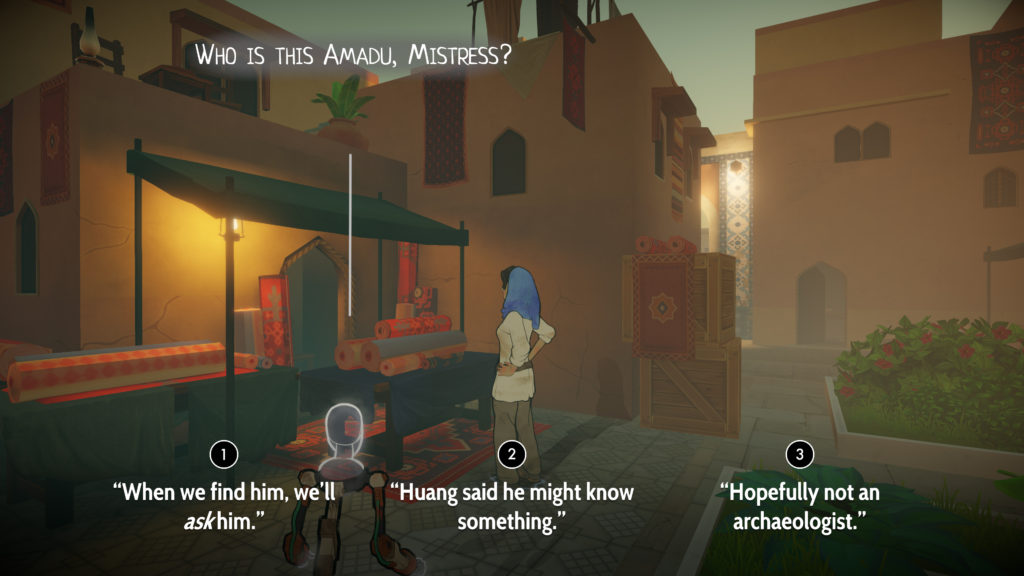
The technology to achieve this feat has been built up over eight years. The company’s games started as traditional branching narratives, with specific text for specific situations. Dream sequences inserted into the later Sorcery games proved that they could plug in extra parts of storytelling in a less rigid manner. Meanwhile, 80 Days had a bank of ocean-crossing tales, which where then tweaked to fit circumstances at that point in the narrative.
“Heaven’s Vault does the same thing with all of its dialogue, feeding it in when it needs to,” Ingold says. “But if they don’t have anything meaningful to say right now they’ll look into a wider bank of more generic topics and if they don’t have anything there then they’ll look into a bank of slightly semi-procedurally generated topics.”
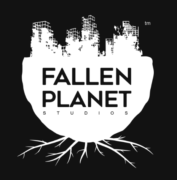
Humfrey continues: “Heaven’s Vault is the first time that we’ve really meshed them, in that one can spark the other, going from specific to general and back again and it just comes together as one,” he tells us proudly. The pair call this ‘narrative tweening’, filling the gaps between the keyframes of the story so to speak, in direct contrast to their approach to animation.
Speaking of visuals, Ink also directs the camera, making sure it’s appropriately-placed for the exposition at that point and this, combined with the text-driven storytelling, means that Ingold has been able to make major script alterations, rewriting entire scenes as desired, even in the last few months of development, when most games would have long locked down their story beats.
“I have been redrafting content on quite significant levels. This whole scene? I don’t like any of it, I’ll rewrite all of that. That takes a day, but it’s now 100 per cent better. I can do that. Whereas if we are a Rockstar, then that’s just not possible, everything’s a cutscene.”
And Ink is being used well beyond Inkle: “Where the Water Tastes Like Wine and Falcon Age are written in Ink, and we just discovered today that Sea of Thieves is written in Ink,” exclaims Humfrey.
HEAVENLY SYMBOLS
With so much to discuss in this intriguing game, it’s taken a while to get around to talking about (though thankfully not in!) Inkle’s own invented language. The pair just refer to it as Ancient, and decoding the hieroglyphic language is the key gameplay element of Heaven’s Vault.
“We spent a while thinking about what archaeologists actually do,” Ingold begins. “It’s quite a lot of digging stuff up, and quite a lot of gluing pots back together and none of this actually sounded as good as it did in the middle of the night. But the idea of translating hieroglyphs was one that really stuck with us.”
Humfrey continues: “We started it more like a traditional cryptogram puzzle. But the more we developed it, the more we wanted to push it in the direction of real linguistics and making it a pictogram puzzle as well, so that you can use all these different sources of information, like what does the symbol look like. Does it look like something from the real world?”
Because of that, they were “influenced quite a lot by Chinese glyphs,” says Humfrey, which are more pictorial than say Egyptian glyphs. “There are other influential languages, such as German, because a lot of its words are built out of smaller words. But we go way further than German, as all of the words are made out of little bits,” Humfrey reveals.
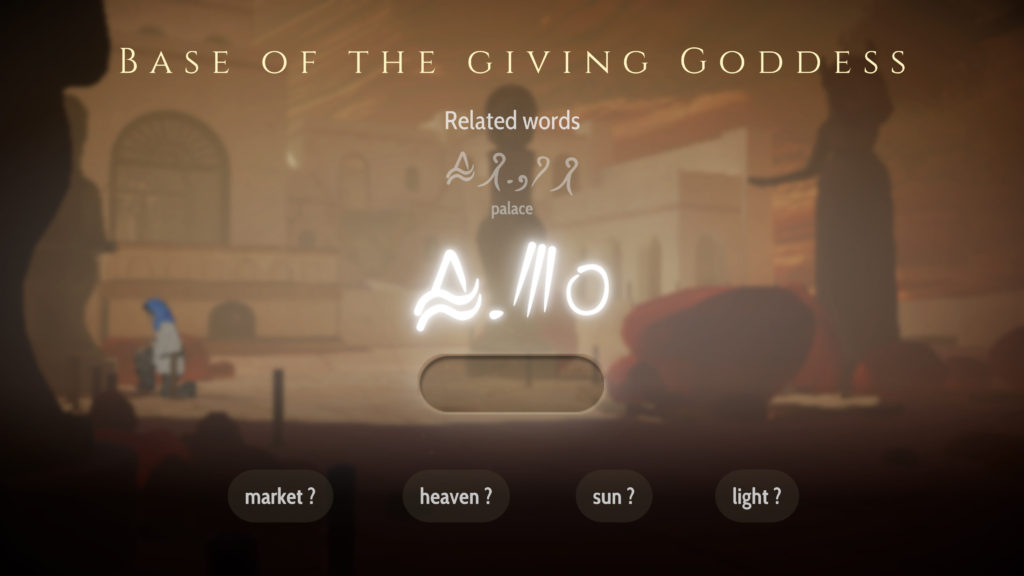
The dictionary for Ancient is now up to a sizeable 3,000 words.
“Linguists say that once you have a thousand words it’s a useful language. Once you learn a thousand words of say German then you can get by,” Humfrey tells us.
Ingold adds: “And just recently it clicked for me, so that when people ask me to translate things into Ancient I can basically type them in and we have it.”
But like the fluid dialogue system, the translation process isn’t hard-gated, so players aren’t forced to come up with the right answers to proceed, Ingold explains:
“It took us about a year and a half to build a mechanic which gently levels up, so it’s more like the puzzles in The Witness than anything else: you get an idea, you expand your idea, you make a translation and what you choose feeds into the narrative. She’ll say ‘this is a temple’ or ‘this is a mausoleum’, based on the translation you guessed. What we don’t tell you is if you’re right.
“So your assumptions, your guesswork, is usually pretty good,” he continues. “People tend not to go completely wrong but if you do get a wrong idea somewhere it can feed into the narrative, feed into your later translations and maybe you might clarify it later when you find another inscription and think: ‘This is definitely not a graveyard’.”
Humfrey enthuses: “It’s a lovely process. And it really is similar to when you’re trying to work out what a word means in another language. If you see that it has commonality, you might say: ‘Oh it’s a bit like this Latin word’ or ‘it must have something to do with this’. And you have the exact same feeling playing Heaven’s Vault.”
And in just a few short days, on April 16th, players will be able to experience that for themselves.

 MCV/DEVELOP News, events, research and jobs from the games industry
MCV/DEVELOP News, events, research and jobs from the games industry
